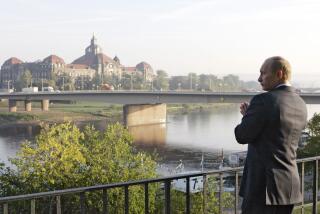Large Hadron Collider rewards scientists watching at Caltech
The Large Hadron Collider near Geneva succeeded early Tuesday in smashing subatomic particles together at more than three times the highest levels previously recorded, eliciting cheers from a crowd watching at Caltech and pushing two sometimes-separate strains of particle physicists together in what is likely to be a show of things to come.
Under two clocks, one labeled âGenevaâ and another labeled âCaltech,â Bertrand Echenard and Matthew Buckley passed midnight with pizza, discovering that they both studied high-energy cosmic ray particle collisions. But Echenard is an experimentalist; Buckley a theorist.
âItâs funny; Iâve seen him at meetings for the last two years,â Buckley said of his fellow postdoctoral candidate. âTurns out weâre working on the same thing.â
With the particle collisions, the work -- and the worlds -- of experimental and theoretical physicists would seem to overlap a bit further.
Only minutes after the first recorded collision, at 3:58 a.m., physicists from various specialties were taking a look at the resulting photos, the first in what promises to be a flood of data from the two beams of protons smashing into each other at a total energy level of 7 trillion electron volts.
Based on experiences with other colliders, it could have taken days for the first collision to occur. Instead, the first collision came only hours after a few failed attempts.
âThere were cheers in all the control rooms,â said Caltech physicist Harvey Newman. âAs soon as we get the data, weâre analyzing it. . . . Itâs been a long time coming.â
The $10-billion, nearly 17-mile-circumference collider will test for particles much smaller than protons, not to mention dark matter, other dimensions, supersymmetry and other theories in particle physics, researchers said.
As the evening got underway, three academic generations consisting of more than two dozen professors, graduate students and undergraduates chatted in a small Caltech meeting room, glancing at two monitors displaying a mosaic of small screens showing the control room near Geneva, as well as colleagues from around the world who were also monitoring the nightâs events.
The buzz of conversation died down each time particles were injected into the two beams in preparation for the planned collision. It resumed amid sighs when researchers near Geneva called off the attempt.
Ten thousand people from 60 countries helped create the collider, whose September 2008 debut was shut down almost immediately because of an electrical short. An April 2009 restart saw more technical problems.
To Echenard, it was a miracle that, with the complexity of the operation, the nightâs events were going as smoothly as they were. Researchers near Geneva had to raise the energy in each beam at the same time that they charged the magnets holding the beam in orbit. Too much charge in the magnets, and the beam would get pulled inward. If there was not enough, the beamâs energy would allow it to break free of its orbit.
For the theorists, it was illuminating. Seeing all of the complications underscores just how difficult an experimentalistâs job really is, said Buckley, the theorist.
âItâs a strange point in history for physics,â he said. âItâs been so long since thereâs been new data that an entire generation of [theoretical] physicists has grown up without dealing in the nitty-gritty.â
He added: âTheorists are going to have to start listening to experimentalists, and hopefully theyâll also be willing to listen to what we have to say.â
As for the experimentalists, Echenard said they could benefit from the theoristsâ impressive skill with espresso.
âWe have coffee on this floor, but not as good as on the [theoristsâ] floor,â he said. âExperimentalists have all the toys, and yet no coffee machine.â (At least at Caltech.)
Tuesday morning, many attendees said they had planned to stay as long as it took for particles to collide and for data to flow in, even though they would not have immediate access to the measurements.
As Echenard put it: âWhen you watch the Olympic Games, you can watch the flame for 15 days, but what you want to watch is the [torch] lighting. . . . It really is the start of something.â
More to Read
Sign up for Essential California
The most important California stories and recommendations in your inbox every morning.
You may occasionally receive promotional content from the Los Angeles Times.








